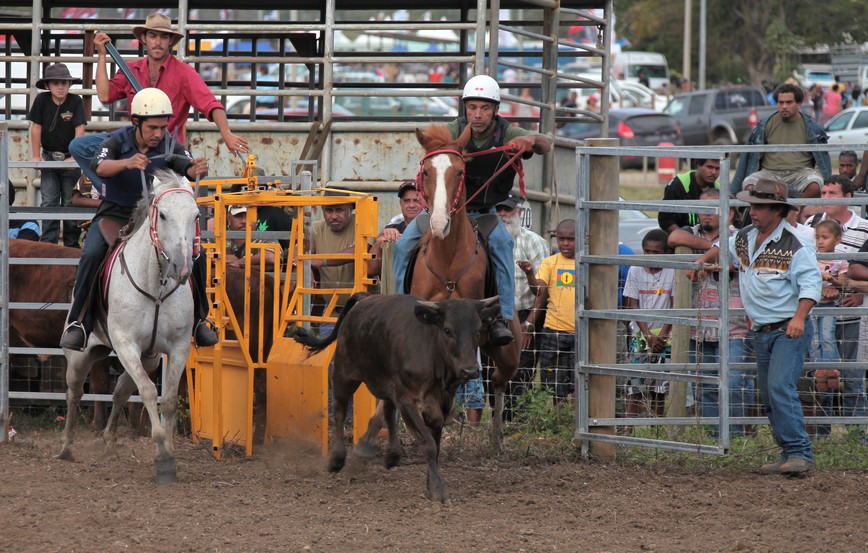BULL-DOGGING
Sauter en marche... pour coucher le veau à terre dans les plus brefs délais.
---------------------
Steer wrestling, also known as bulldogging, is a rodeo event in which a horse-mounted rider chases a steer, drops from the horse to the steer, then wrestles the steer to the ground by twisting its horns. Like all rodeo events, there are concerns from the animal rights community that the competition may include practices that constitute cruelty to animals. The event also carries a high risk of injury to the cowboy. Historically, steer wrestling was not a part of ranch life. The event originated in the 1930s, and is claimed to have been started by an individual named Bill Pickett, a Wild West Show performer said to have caught a runaway steer by wrestling it to the ground. There are several versions of the story, some claiming that he developed the idea after he observed how cattle dogs worked with unruly animals.
The event features a steer and two mounted cowboys, along with a number of supporting characters. The steers are moved through narrow pathways leading to a chute with spring-loaded doors. A barrier rope is fastened around the steer's neck which is used to ensure that the steer gets a head start. The rope length is determined by arena length. On one side of the chute is the "hazer", whose job is to ride parallel with the steer once it begins running and ensure it runs in a straight line, on the other side of the chute the "steer wrestler" or "bulldogger" waits behind a taut rope fastened with an easily broken string which is fastened to the rope on the steer.
When the steer wrestler is ready he "calls" for the steer by nodding his head and the chute man trips a lever opening the doors. The suddenly freed steer breaks out running, shadowed by the hazer. When the steer reaches the end of his rope, it pops off and simultaneously releases the barrier for the steer wrestler. The steer wrestler attempts to catch up to the running steer, lean over the side of the horse which is running flat out and grab the horns of the running steer. The steer wrestler then is pulled off his horse by the slowing steer and plants his heels into the dirt further slowing the steer and himself. He then takes one hand off the horns, reaches down and grabs the nose of the steer pulling the steer off balance and ultimately "throwing" the steer to the ground. Once all four legs are off the ground, an official waves a flag marking the official end and a time is taken. The steer is released and trots off.
Technique
The preferred method of wrestling the steer to the ground is to lean from the galloping horse which is running beside the steer, transferring the weight of the upper body to the neck of the steer, with one hand on the near horn of the steer and the far horn grasped in the crook of the other elbow. One then lets the horse carry his feet by the steer until his feet naturally fall out of the stirrups. The steer wrestler then slides with his feet turned slightly to the left, twisting the head of the steer toward one by pushing down with the near hand and pulling up and in with the far elbow. Finally the steer wrestler lets go of the near horn, and puts the steers nose in the crook of his left elbow, and throws his weight backwards causing the steer to become unbalanced and fall to the ground.
Rules
Rules of steer wrestling include: The bulldogger's horse must not break the rope barrier in front of it at the beginning of a run, but must wait for the animal escaping from the adjacent chute to release the rope. Breaking the rope barrier early adds a 10 second penalty to the bulldogger's time. If the steer stumbles or falls before the bulldogger brings it down, he must either wait for it to rise or help it up before wrestling it to the ground. If the bulldogger completely misses the steer on his way down, he will receive a "no time". Typical professional times will be in the range of 3.0 to 10 seconds from the gates opening to the waving of the flag. The steers used today are generally Corriente cattle or longhorns, which weigh between 450–650 pounds, and the human steer wrestlers typically weigh 180–300 pounds. While steer wrestlers have a lower injury rate than bull riders or bronc riders, their injury rate is higher than that of the speed events.
